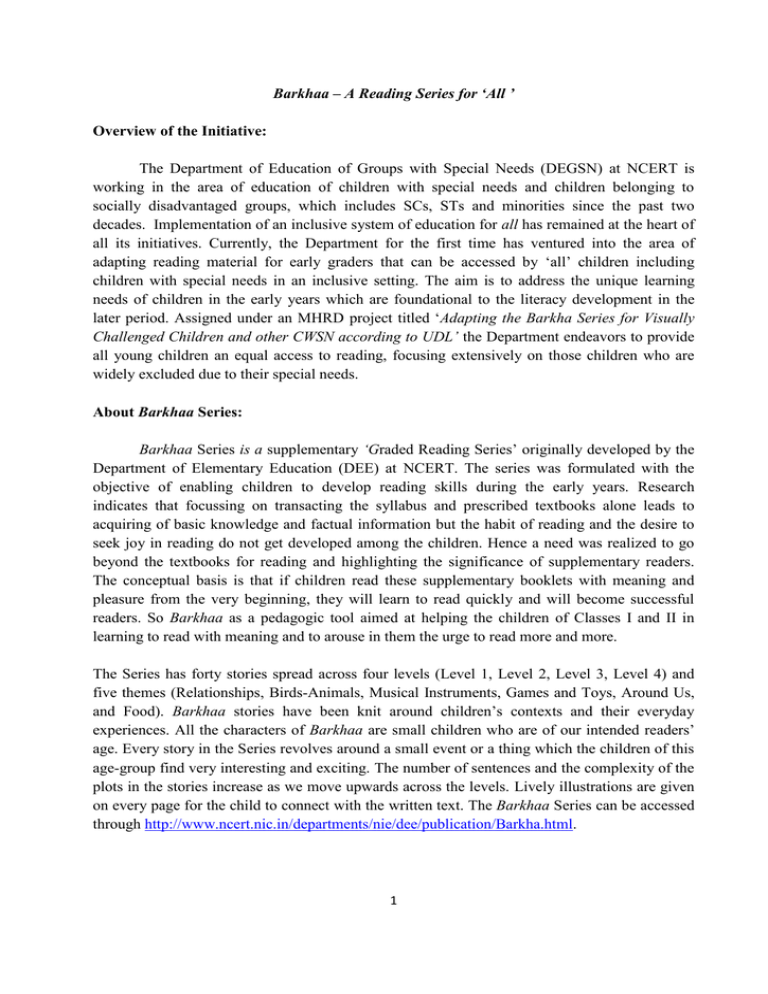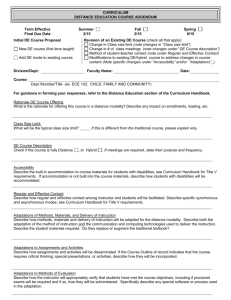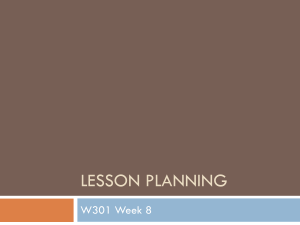Barkhaa – A Reading Series for ‘All ’
advertisement

Barkhaa – A Reading Series for ‘All ’ Overview of the Initiative: The Department of Education of Groups with Special Needs (DEGSN) at NCERT is working in the area of education of children with special needs and children belonging to socially disadvantaged groups, which includes SCs, STs and minorities since the past two decades. Implementation of an inclusive system of education for all has remained at the heart of all its initiatives. Currently, the Department for the first time has ventured into the area of adapting reading material for early graders that can be accessed by ‘all’ children including children with special needs in an inclusive setting. The aim is to address the unique learning needs of children in the early years which are foundational to the literacy development in the later period. Assigned under an MHRD project titled ‘Adapting the Barkha Series for Visually Challenged Children and other CWSN according to UDL’ the Department endeavors to provide all young children an equal access to reading, focusing extensively on those children who are widely excluded due to their special needs. About Barkhaa Series: Barkhaa Series is a supplementary ‘Graded Reading Series’ originally developed by the Department of Elementary Education (DEE) at NCERT. The series was formulated with the objective of enabling children to develop reading skills during the early years. Research indicates that focussing on transacting the syllabus and prescribed textbooks alone leads to acquiring of basic knowledge and factual information but the habit of reading and the desire to seek joy in reading do not get developed among the children. Hence a need was realized to go beyond the textbooks for reading and highlighting the significance of supplementary readers. The conceptual basis is that if children read these supplementary booklets with meaning and pleasure from the very beginning, they will learn to read quickly and will become successful readers. So Barkhaa as a pedagogic tool aimed at helping the children of Classes I and II in learning to read with meaning and to arouse in them the urge to read more and more. The Series has forty stories spread across four levels (Level 1, Level 2, Level 3, Level 4) and five themes (Relationships, Birds-Animals, Musical Instruments, Games and Toys, Around Us, and Food). Barkhaa stories have been knit around children’s contexts and their everyday experiences. All the characters of Barkhaa are small children who are of our intended readers’ age. Every story in the Series revolves around a small event or a thing which the children of this age-group find very interesting and exciting. The number of sentences and the complexity of the plots in the stories increase as we move upwards across the levels. Lively illustrations are given on every page for the child to connect with the written text. The Barkhaa Series can be accessed through http://www.ncert.nic.in/departments/nie/dee/publication/Barkha.html. 1 The need to ‘adapt’ Barkhaa Series One of the key characteristics of inclusive education is the provision of a curriculum that is appropriate for each child and focuses on the unique learning needs, characteristics, interests and strengths of children at different developmental levels. Children with a learning disability, speech or language disorder, hearing or visual impairment, physical disability, autism spectrum disorder (ASD), attention deficit hyperactivity disorder (ADHD), or other type of disabilities may need special accommodations, modifications and adaptations in the teaching learning material to access it. Abiding to the ethos of inclusion, the current project endeavors to bring about potential adaptations in the Barkhaa Series to ensure that children with disabilities can be included in the reading process along with other children. The core objective is to respect diverse reading choices and facilitate access of each child to this reading material. Hence a number of innovations are being incorporated in appropriate ways (without changing the original series) by providing the information in Braille, tactile, sign language, digital mode etc so that all children with disabilities have full access to the content of the Series and can read them along with other children. Groundwork The Department had organised numerous workshops at the National level to get insight into the nature of adaptations required in the Barkhaa Series to cater to the varied needs of children. The national workshops witnessed the participation of teacher educators, special educators, teachers working in special schools, inclusive schools, NCERT faculty, representatives from UNICEF, SSA, professionals working in the area of IT, professionals involved in producing tactile material for VI children etc. These resource persons also carried out a pre-try out of the original Barkhaa Series in their respective institutions to gauge its affectivity among children with disabilities. Their experiences were later discussed in the workshops. During the workshops the resource persons delineated specific needs for various disability groups and accordingly suggested adaptations in the Series keeping in mind the principles of Universal Design for learning principle (UDL1). The development of a manual/guidebook/handbook for teachers in reference to the adapted series was also suggested. The inputs from these workshops were then analysed, discussed and finalised by the DEGSN team to formulate a draft of the suggested adaptations. 1 UDL is a systematic approach to design learning activities and materials. This is not a single, one-size-fits-all solution but a flexible approach that can be customized and adjusted for individual needs. 2 Barkhaa Series with ‘Adaptations’ The draft generated as a follow up to the workshop inputs had the following key components: Print and Digital version of Barkhaa Series with ‘adaptations’ and a Handbook for Teachers and Parents. This Series with ‘adaptations’ aims to cover the needs of all children including children with special needs at the primary level. The objective of promoting optimum participation and learning for ‘all’ children during early years are being catered through a series of innovative incorporations in the original Barkhaa booklets. The print version of the adapted series will have the text in Braille and visuals in tactile form to provide a multi sensory experience to the readers. Other features like page gradation to turn pages, arrows to indicate the next page, markers for start and end of the sentences, picture windows for difficult words and many such essentials have been added to make it accessible to all children. In addition, a Teachers and Parents page at the end of each booklet have been integrated to help facilitate the reading process in the classroom and as well as at home. Concerns like binding of the book, page texture, page length and orientation have also been considered keeping in mind the needs of early years of children with disabilities. The booklets will also be available in Digital format which can be accessed by all children including children with low vision. This version will include a guide video to help young children navigate easily. The digital content will have features like different background colour combinations, option to increase size of text and image, pop ups flashcards and other such customisations. An introductory audio note has been added in each booklet to arouse curiosity and motivate the child to read. The audio note is also available in sign language in the digital version. In addition a Handbook for Teachers and Parents consisting of detailed understanding and suggestions on various aspects like characteristics of children with various disabilities, their learning needs in early years, adaptations made in the Barkhaa Series etc will be provided. It will also have a section on FAQs composing of queries pertaining to related topics. You may also send in your questions to be answered. 3





